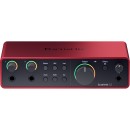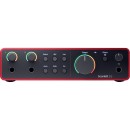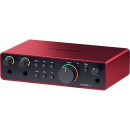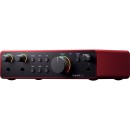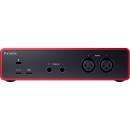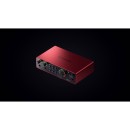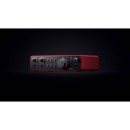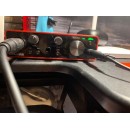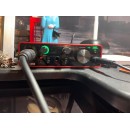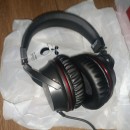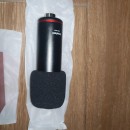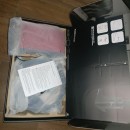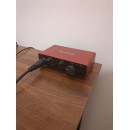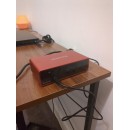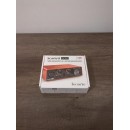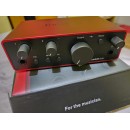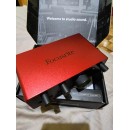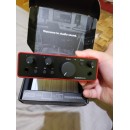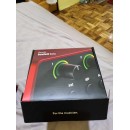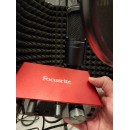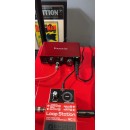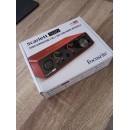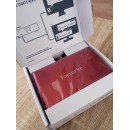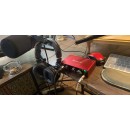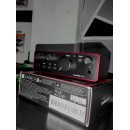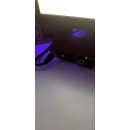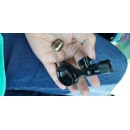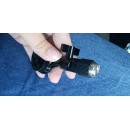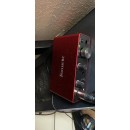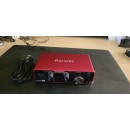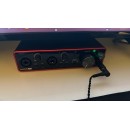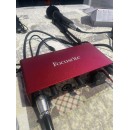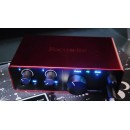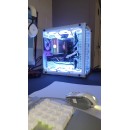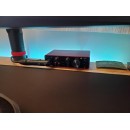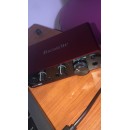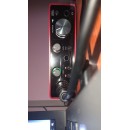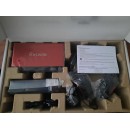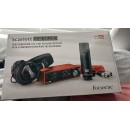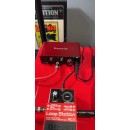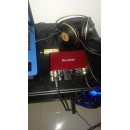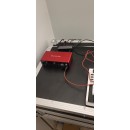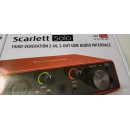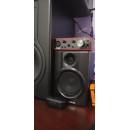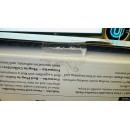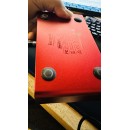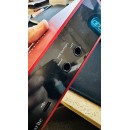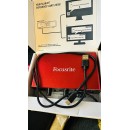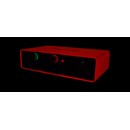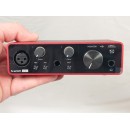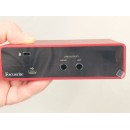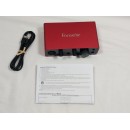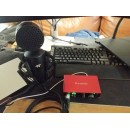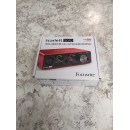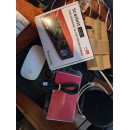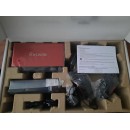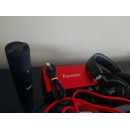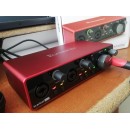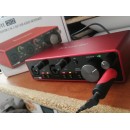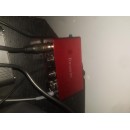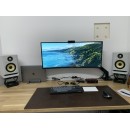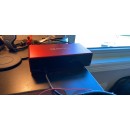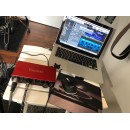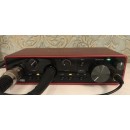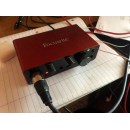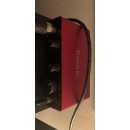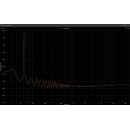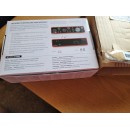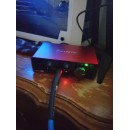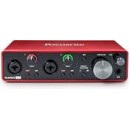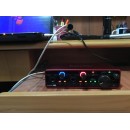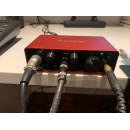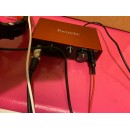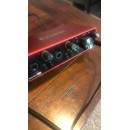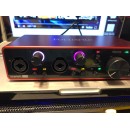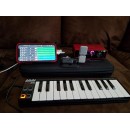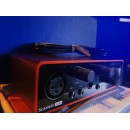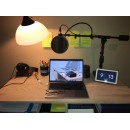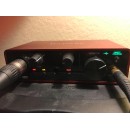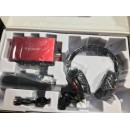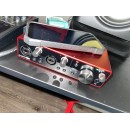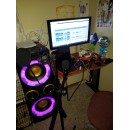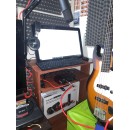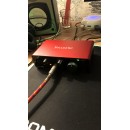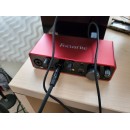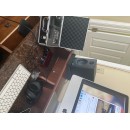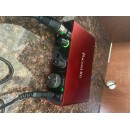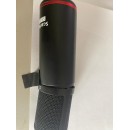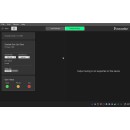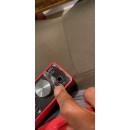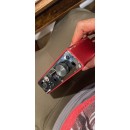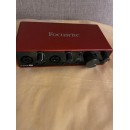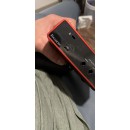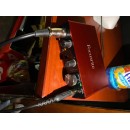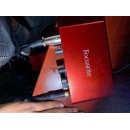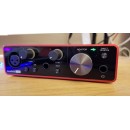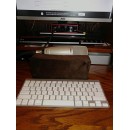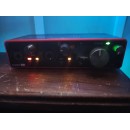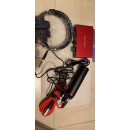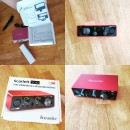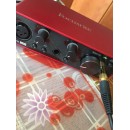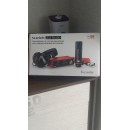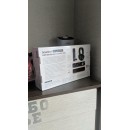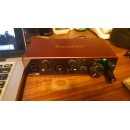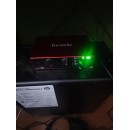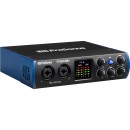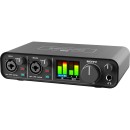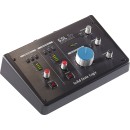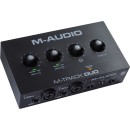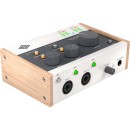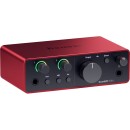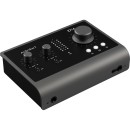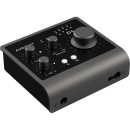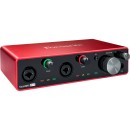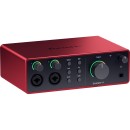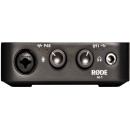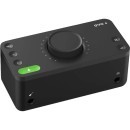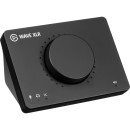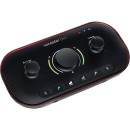Focusrite Scarlett 2i2 USB-C Audio Interface (4th Generation) - Comprehensive Review
- Two high-performance Scarlett mic preamps with switchable Air mode for a brighter, more open sound.
- High-headroom instrument input for guitars or basses.
- High-performance converters enabling recording and playback at 24-bit/192kHz.
- Two balanced line inputs for connecting synthesizers, drum machines, and other line-level sources.
- USB-C connectivity for fast and reliable data transfer.
- Direct Monitoring feature to listen to your recordings without latency.
- Easy-to-use Gain Halos for visual level indication.
- Comprehensive software bundle including Ableton Live Lite and a suite of production tools and plugins.
- Compact and rugged design, ideal for portable setups.
Focusrite Scarlett 2i2 4th Gen: Specifications, Advantages, and Disadvantages
The Focusrite Scarlett 2i2 USB-C Audio Interface (4th Generation) is a premium audio interface designed for musicians, producers, and podcasters who demand high-quality sound and reliable performance. This latest iteration of the Scarlett 2i2 series boasts world-class preamps and converters, ensuring crystal clear audio capture and playback. The device features two high-headroom instrument inputs and two balanced line outputs, making it versatile enough for a range of recording setups.
One of the standout features of the Scarlett 2i2 4th Generation is its ultra-low latency, allowing for real-time monitoring and seamless recording experiences. The USB-C connectivity ensures fast data transfer and compatibility with modern computers and devices. Additionally, the audio interface is bundled with a comprehensive software suite, including DAWs and plug-ins, providing users with all the tools they need to start creating right out of the box.
With its solid build quality, intuitive design, and enhanced audio performance, the Focusrite Scarlett 2i2 USB-C Audio Interface (4th Generation) is an excellent choice for anyone looking to elevate their recording and production capabilities. Whether you're in a professional studio or a home setup, this interface delivers reliable and high-fidelity sound every time.
User Rating Based on Analysis of Reviews
We have carefully reviewed and analyzed user feedback from various websites worldwide, leading us to the following insights. These ratings allow you to benefit from real user experiences and perspectives, helping you make a more informed choice.
Purchase Value
85% of users expressed satisfaction with the purchase value of the Focusrite Scarlett 2i2 USB-C Audio Interface. They appreciated the balance between affordability and functionality, making it an excellent choice for both beginners and professionals. Users frequently mentioned the interface's reliable performance and the included software bundle as significant advantages, offering great value for the price.
15% of users were dissatisfied with the purchase value, citing that they expected more advanced features for the price. Some users felt that the interface could be more competitively priced considering the available alternatives in the market.
Quality of Materials
90% of users were satisfied with the quality of materials used in the Focusrite Scarlett 2i2 USB-C Audio Interface. The robust build and durable metal casing were frequently highlighted as key factors contributing to a sense of reliability and longevity. Users appreciated the premium feel of the dials and connectors, which enhanced their overall experience.
10% of users expressed dissatisfaction with the quality of materials, noting that some components felt slightly less durable over time. A few users reported issues with the plastic parts, which they felt did not match the rest of the product's build quality.
Ease of Use
88% of users found the Focusrite Scarlett 2i2 USB-C Audio Interface easy to use. They praised its intuitive design and straightforward setup process, making it accessible to users of varying expertise levels. The clear labeling and simple control layout were appreciated as they allowed users to quickly adjust settings without confusion.
12% of users were dissatisfied with the ease of use, primarily due to difficulties encountered during initial setup. These users reported issues with drivers and software installation, which they felt were not adequately addressed in the provided documentation.
Sound Quality
92% of users were impressed with the sound quality of the Focusrite Scarlett 2i2 USB-C Audio Interface, noting its clear and crisp audio output as a standout feature. Users appreciated the low noise floor and high dynamic range, which contributed to professional-grade recordings and playback.
8% of users expressed dissatisfaction with the sound quality, mentioning occasional latency issues and minor distortion at high volumes. Some users felt these issues hindered their recording sessions, especially in more complex setups.
Compatibility
87% of users were satisfied with the compatibility of the Focusrite Scarlett 2i2 USB-C Audio Interface, citing its seamless integration with various DAWs and operating systems as a major advantage. Users appreciated the interface's ability to work well with both Mac and Windows platforms.
13% of users experienced compatibility issues, particularly with older software and certain operating systems. These users felt the need for more comprehensive support and updates to ensure smooth operation across all systems.
Portability
85% of users praised the portability of the Focusrite Scarlett 2i2 USB-C Audio Interface, highlighting its compact size and lightweight design. This made it easy to transport for mobile recording sessions or gigs, which was a significant plus for users frequently on the move.
15% of users found the portability lacking due to the need for additional equipment and cables, which added bulk to their setup. Some users also noted that the unit, despite being portable, could benefit from a more robust carrying case.
Durability
88% of users were satisfied with the durability of the Focusrite Scarlett 2i2 USB-C Audio Interface, often commenting on its sturdy construction. Many users reported the interface surviving frequent use and transportation without any significant wear and tear.
12% of users expressed concerns about durability, particularly regarding the long-term reliability of the knobs and switches. Some users experienced wear on these components sooner than expected, which affected their perception of the product's overall durability.
Aesthetics
90% of users were pleased with the aesthetics of the Focusrite Scarlett 2i2 USB-C Audio Interface, often mentioning its sleek and modern design. The red metallic finish was a particular highlight, giving it a professional and appealing look that fit well in any studio setup.
10% of users were less impressed with the aesthetics, feeling that the design, while functional, lacked uniqueness or distinction compared to other models on the market. Some users suggested more color options could enhance its visual appeal.
Customer Support
82% of users praised Focusrite's customer support, mentioning prompt responses and helpful assistance with technical inquiries. Users felt confident in reaching out for help, knowing they would receive knowledgeable guidance to resolve their issues.
18% of users were dissatisfied with customer support, citing delayed responses and unhelpful troubleshooting advice. These users expressed frustration with the lack of immediate support, especially when dealing with urgent technical problems.
Latency
89% of users were satisfied with the low latency performance of the Focusrite Scarlett 2i2 USB-C Audio Interface. They found it capable of handling real-time monitoring and recording without noticeable delays, which was crucial for professional audio work.
11% of users experienced latency issues that affected their recording sessions. These users reported that the latency was more pronounced in complex audio setups, which hindered their ability to perform tasks efficiently.
Driver Stability
83% of users were satisfied with the driver stability of the Focusrite Scarlett 2i2 USB-C Audio Interface. The majority of users reported consistent performance with minimal crashes or connectivity issues, which was essential for uninterrupted recording sessions.
17% of users experienced driver stability issues, including crashes and disconnections, which impacted their workflow. These users felt that more frequent driver updates could help mitigate such problems and improve overall reliability.
Preamp Quality
91% of users were highly satisfied with the preamp quality of the Focusrite Scarlett 2i2 USB-C Audio Interface. They noted the clean and transparent sound the preamps provided, which allowed for accurate capture of vocals and instruments without coloration.
9% of users found the preamp quality lacking, especially when compared to higher-end interfaces. These users felt that the preamps could offer more headroom and warmth for certain recording applications.
Software Bundle
86% of users appreciated the software bundle included with the Focusrite Scarlett 2i2 USB-C Audio Interface. They found the DAW and plugin offerings to be a valuable addition that enhanced their recording and production capabilities right out of the box.
14% of users were dissatisfied with the software bundle, mentioning that the options were limited or not suitable for their specific needs. Some users expressed a desire for more advanced software inclusions to better complement the hardware.
Input/Output Options
84% of users were satisfied with the input/output options available on the Focusrite Scarlett 2i2 USB-C Audio Interface. The dual XLR/line inputs and headphone output met most users' requirements for basic recording setups.
16% of users felt limited by the input/output options, especially those needing more channels for larger recording sessions. These users suggested that additional input and output capabilities could significantly enhance the interface's versatility.
Phantom Power
87% of users appreciated the inclusion of phantom power on the Focusrite Scarlett 2i2 USB-C Audio Interface, enabling them to use condenser microphones effectively. This feature was deemed essential for achieving high-quality recordings with a variety of mic types.
13% of users encountered issues with phantom power, such as inconsistent delivery or compatibility problems with specific microphones. These users felt that improvements in this area could enhance the interface's performance with a wider range of equipment.
USB-C Connectivity
89% of users were pleased with the USB-C connectivity of the Focusrite Scarlett 2i2 Audio Interface, noting the faster data transfer and improved power efficiency. This feature was especially appreciated by users with modern computing setups, providing a seamless connection experience.
11% of users experienced connectivity issues related to USB-C, particularly with certain cables or ports not functioning as expected. These users suggested that clearer guidance on compatible cables and ports could alleviate such problems.
Overall Satisfaction
88% of users expressed overall satisfaction with the Focusrite Scarlett 2i2 USB-C Audio Interface, citing it as a reliable and high-performance tool for their audio needs. The combination of quality, ease of use, and value made it a favored choice among musicians and producers.
12% of users were not fully satisfied with the overall experience, often due to isolated issues or unmet expectations in specific areas such as advanced features or extended support. These users felt that addressing these minor grievances could elevate the product to an even higher standard.
Recording Quality
91% of users were highly satisfied with the recording quality provided by the Focusrite Scarlett 2i2 USB-C Audio Interface. They noted its ability to capture detailed and accurate audio, making it suitable for various applications from podcasts to music production.
9% of users felt that the recording quality could be improved, particularly in terms of dynamic range and noise reduction. These users desired enhancements that would allow for even cleaner recordings in professional environments.
Monitor Control
86% of users appreciated the monitor control features of the Focusrite Scarlett 2i2 USB-C Audio Interface, particularly the direct monitor switch and volume control. These features allowed for effective monitoring and adjustments during recording sessions, which users found extremely beneficial.
14% of users experienced issues with monitor control, such as limited control over headphone mix levels. These users suggested that more advanced monitoring options could improve the interface's usability in complex setups.
Updates and Support
80% of users were satisfied with the updates and support provided for the Focusrite Scarlett 2i2 USB-C Audio Interface. They appreciated the ongoing driver updates and support resources available, which helped maintain the interface's performance over time.
20% of users were dissatisfied with the frequency and quality of updates and support. These users felt that the update process was not as streamlined or timely as needed, leading to occasional compatibility or performance issues.
Product Longevity
87% of users were satisfied with the product longevity of the Focusrite Scarlett 2i2 USB-C Audio Interface, reporting that it remained functional and reliable over extended periods of use. This aspect contributed to users' confidence in their investment.
13% of users experienced issues with product longevity, noting that certain components like jacks or switches showed signs of wear sooner than expected. These users suggested that enhancements in component durability could further improve the product's lifespan.
In this section, we will delve into the detailed specifications of the Focusrite Scarlett 2i2 USB-C Audio Interface (4th Generation). Following that, we will thoroughly review the advantages and disadvantages of this product to help you make an informed decision about its suitability for your audio needs.
Pros:
- High-quality preamps for clear audio capture.
- USB-C connectivity for faster data transfer and compatibility.
- Compact and portable design.
- Low latency monitoring.
- Easy setup and user-friendly interface.
Cons:
- Limited to two inputs, which may not be enough for some users.
- No MIDI input/output.
- Higher price point compared to some competitors.
- Requires external power when used with some devices.
General
| Channels of I/O | Analog: 2 Inputs / 2 Outputs at 192 kHz |
|---|---|
| Built-In DSP | |
| Maximum Sampling Rate | 192 kHz / 24-Bit |
| Number of Microphone Inputs | 2 |
| Built-In Microphone | |
| Input Level Adjustment | 2x Knob |
| Expansion Slots |
The specifications of the Focusrite Scarlett 2i2 USB-C Audio Interface (4th Generation) provide essential information about its audio capabilities and functionality.Show More
Channels of I/O: This feature indicates the number of input and output channels available for audio processing. With 2 inputs and 2 outputs at a high sampling rate of 192 kHz, the Scarlett 2i2 allows for capturing and playing back stereo sound, making it suitable for music production and podcasting.
Built-In DSP: Digital Signal Processing (DSP) refers to the ability to process audio signals digitally. In this case, the Scarlett 2i2 does not come with built-in DSP, which means users will need to rely on external software for effects and processing, offering more flexibility in terms of software choices.
Maximum Sampling Rate: This specification denotes the highest rate at which audio can be recorded and played back. A maximum sampling rate of 192 kHz and a bit depth of 24-bit ensure high-resolution audio quality, capturing more detail and nuance in sound, which is vital for professional recordings.
Number of Microphone Inputs: The Scarlett 2i2 features 2 microphone inputs, allowing for the connection of two microphones simultaneously. This is particularly useful for recording duets, interviews, or for capturing multiple sound sources at once.
Built-In Microphone: This feature indicates that the Scarlett 2i2 does not include a built-in microphone. Users will need to connect their own microphones to utilize this interface, giving them the freedom to choose the best mic for their specific recording needs.
Input Level Adjustment: The interface is equipped with 2 knobs for adjusting input levels, allowing users to control the gain for each microphone input. This feature is crucial for achieving the right recording levels and preventing distortion, ensuring optimal sound quality.
Expansion Slots: The Scarlett 2i2 does not have any expansion slots, meaning it does not support additional hardware upgrades or add-ons. However, its design focuses on providing essential features for direct audio recording without the complexity of modular expansions.
Signal Processing
| Gain/Trim Range | Mic/Line Inputs: Up to +69 dB Hi-Z Inputs: 62 dB |
|---|
The Gain/Trim Range specifications indicate the adjustable levels of amplification available for the microphone and line inputs, as well as the high-impedance (Hi-Z) inputs on the Focusrite Scarlett 2i2 USB-C Audio Interface. Show More
For the mic/line inputs, a gain range of up to +69 dB means that users can significantly amplify the signal coming from their microphones or other line-level sources. This is particularly useful for capturing quiet sounds or detailed audio, ensuring that the input signal is strong enough for optimal recording without introducing excessive noise or distortion.
On the other hand, the Hi-Z inputs, designed for high-impedance instruments like electric guitars and basses, have a gain range of 62 dB. This level of gain allows for proper amplification of these instruments, making it possible to achieve a full, rich sound when recording. Both gain ranges provide users with the flexibility to tailor the input levels to suit various audio sources, enhancing overall recording quality.
Connectivity
| Analog Audio I/O | 2x XLR 3-Pin Balanced Mic Input 2x 1/4" TRS Balanced/Unbalanced Line/Hi-Z Input (Front Panel) 2x 1/4" TRS Balanced Monitor Output 1x 1/4" TRS Headphone Output (Front Panel) |
|---|---|
| Phantom Power | 48 V, Selectable On/Off |
| Digital Audio I/O | |
| Host Connection | 1x USB-C |
| Host Connection Protocol | USB 2.0 |
| USB (Non-Host) | 1x USB-C (Power Input) |
| Sync I/O | |
| Network I/O | |
| MIDI I/O | |
| Wireless |
The Focusrite Scarlett 2i2 USB-C Audio Interface (4th Generation) boasts a range of specifications designed to enhance audio recording and playback experiences. Show More
Analog Audio I/O refers to the input and output options available for analog signals. This device features two XLR 3-pin balanced mic inputs, which allow you to connect a variety of microphones for high-quality sound capture. The inclusion of two 1/4" TRS balanced/unbalanced line/Hi-Z inputs on the front panel provides versatility, enabling users to connect instruments directly, like guitars, as well as line-level sources. Additionally, there are two 1/4" TRS balanced monitor outputs for connecting studio monitors, and a dedicated 1/4" TRS headphone output for monitoring audio without latency.
Phantom Power is a crucial feature for condenser microphones that require external power to operate. The Scarlett 2i2 provides 48 V of phantom power, which can be easily toggled on or off, allowing users to power their microphones without the need for additional equipment.
Digital Audio I/O indicates whether the device supports digital audio connections, and in this case, the Scarlett 2i2 does not offer this feature.
Host Connection specifies the way the audio interface connects to a computer. The Scarlett 2i2 uses a USB-C connection, which is compatible with USB 2.0 protocols, ensuring a stable and efficient data transfer for recording and playback.
USB (Non-Host) refers to the additional USB-C port on the device, which is used for power input. This is essential for providing the necessary power to the interface while it operates.
There are no Sync I/O, Network I/O, MIDI I/O, or Wireless features on this unit, indicating it is focused primarily on analog audio connections and does not support synchronization with other digital devices or wireless functionality. This simplicity can be advantageous for users seeking a straightforward audio interface for recording and mixing.
Performance
| Frequency Response | XLR Mic Inputs: 20 Hz to 20 kHz ±0.06 dB 1/4" Line Inputs: 20 Hz to 20 kHz 0.05 dB 1/4" Hi-Z Inputs: 20 Hz to 20 kHz 0.15 dB |
|---|---|
| Maximum Input Level | XLR Mic: 16 dBu 1/4" Line: 22 dBu 1/4" Hi-Z: 12 dBu |
| Maximum Output Level | 1/4" Line: +16 dBu |
| Headphone Output Power | 1/4": 32 mW into 33 Ohms 22 mW into 300 Ohms |
| Impedance | XLR Mic Inputs: 3 Kilohms 1/4" Line Inputs: 60 Kilohms 1/4" Hi-Z Inputs: 1 Megohms 1/4" Line Outputs: 100 Ohms 1/4" Headphone Outputs: < 50 Ohm |
| Dynamic Range | XLR Mic Inputs: 116 dBA 1/4" Line Inputs: 115.2 dBA 1/4" Hi-Z Inputs: 113 dBA 1/4" Line Outputs: 120 dB 1/4" Headphone: 112 dB (at 33 Ohms) 115 dB (at 300 Ohms) Digital A/D Converters: 120 dB Digital D/A Converters: 130 dBA |
| THD+N | XLR Mic Inputs: -100 dB (at 8 dB Gain) 1/4" Line Inputs: -100 dB (at 8 dB Gain) 1/4" Hi-Z Inputs: -80 dB (at Minimum Gain) 1/4" Line Outputs: -109 dB 1/4" Headphone Outputs: -99 dB (at 33 Ohms) -108 dB (at 300 Ohms) Digital A/D Converters: -110 dB Digital D/A Converters: -115 dB |
| EIN | XLR Mic Inputs: -127 dBu A-Weighted |
The specifications for the Focusrite Scarlett 2i2 USB-C Audio Interface (4th Generation) highlight its capabilities in audio performance, ensuring high-quality recording and playback. Show More
Frequency Response indicates the range of frequencies the device can accurately reproduce. The specified range of 20 Hz to 20 kHz for the XLR mic and line inputs signifies the interface's ability to capture the full spectrum of human hearing, providing clarity and detail in recordings. The small variation in dB values across the input types (±0.06 dB for XLR, 0.05 dB for line inputs, and 0.15 dB for Hi-Z inputs) reflects minimal deviation from the intended frequency response, which is crucial for professional audio work.
Maximum Input Level defines the highest signal level the inputs can handle before distortion occurs. The XLR mic input can manage up to 16 dBu, while the 1/4" line input can take up to 22 dBu. This indicates that the interface can accommodate strong signals from various sources without compromising audio integrity. The lower maximum input level for Hi-Z inputs (12 dBu) is typical for instruments, ensuring proper signal handling without overload.
Maximum Output Level refers to the highest output level the interface can deliver without distortion, with a specification of +16 dBu for the 1/4" line outputs. This ensures compatibility with a wide range of external equipment, allowing for effective signal transmission.
Headphone Output Power indicates the interface's ability to drive headphones, with the output power varying based on impedance. The ability to deliver 32 mW into 33 Ohms and 22 mW into 300 Ohms demonstrates the device's versatility in accommodating different headphone models and maintaining audio fidelity.
Impedance values for various inputs and outputs reflect the interface's compatibility with different audio sources. The XLR mic inputs at 3 Kilohms, 1/4" line inputs at 60 Kilohms, and Hi-Z inputs at 1 Megohm signify that the interface is designed to work well with a wide variety of microphones and instruments, ensuring optimal performance.
Dynamic Range measures the difference between the quietest and loudest sounds the interface can handle, with impressive values such as 116 dBA for XLR mic inputs and 120 dB for line outputs. A high dynamic range is essential in professional audio applications, allowing for detailed sound reproduction across various volumes.
THD+N (Total Harmonic Distortion plus Noise) indicates the level of distortion introduced to the signal. The low figures for XLR mic inputs at -100 dB and line outputs at -109 dB suggest that the Scarlett 2i2 maintains high sound quality, minimizing unwanted artifacts in the audio.
Finally, EIN (Equivalent Input Noise) for XLR mic inputs at -127 dBu A-Weighted indicates the low noise level of the interface, which is crucial for recording quiet sources without introducing noticeable background noise. This specification is vital for maintaining clarity and detail in recordings.
Overall, these specifications highlight the Focusrite Scarlett 2i2's design for quality sound production, making it a reliable choice for both amateur and professional audio applications.
Digital Audio
| Sample Rates | 44.1 / 48 / 88.2 / 96 / 176.4 / 192 kHz |
|---|---|
| Bit Depths | 24-Bit |
| Sync Sources | Internal |
The specifications of the Focusrite Scarlett 2i2 USB-C Audio Interface (4th Generation) include various important features that influence its performance in audio recording and playback.Show More
Sample Rates: The sample rates available for the Scarlett 2i2 range from 44.1 kHz to 192 kHz. Sample rate refers to the number of times audio is sampled per second. Higher sample rates can capture more detail in the audio, resulting in better sound quality, especially for high-frequency sounds. For most music applications, 44.1 kHz or 48 kHz is sufficient, but for professional recordings or specific audio projects, higher rates like 88.2 kHz or 192 kHz may be used.
Bit Depths: This interface supports a bit depth of 24-bit. Bit depth determines the dynamic range of the audio signal, with higher values allowing for a greater range of volume levels to be captured, thus reducing the risk of distortion and noise. A 24-bit depth is standard in professional audio environments, providing a substantial improvement over the 16-bit depth commonly used in consumer audio.
Sync Sources: The Scarlett 2i2 has an internal sync source, meaning it relies on its own internal clock for timing during audio recording and playback. This provides stability and consistency in audio performance. Internal synchronization is typical in audio interfaces and works well for most recording situations, ensuring that multiple tracks are aligned properly without drift.
These specifications collectively contribute to the interface’s capability to deliver high-quality audio, making it suitable for both amateur and professional users seeking reliable performance in their audio projects.
Audio Storage & Playback
| Media/Memory Card Slot |
|---|
The Media/Memory Card Slot feature refers to the presence of a slot that allows users to insert a memory card for data storage or audio recording. In the case of the Focusrite Scarlett 2i2 USB-C Audio Interface, there is no dedicated media or memory card slot. This means that users will not be able to directly record audio onto a memory card through the interface itself. Instead, audio is typically recorded on a connected computer using appropriate software.Show More
The absence of a memory card slot indicates that the Scarlett 2i2 relies on USB connectivity to manage audio data. This can be seen as advantageous for many users who prefer the flexibility and larger storage capacity of a computer's hard drive or SSD, as well as the increased processing power available for audio editing and mixing. However, for those who seek standalone recording capabilities without the need for a computer, the lack of a memory card slot may be a limiting factor.
Compatibility
| OS Compatibility | macOS Windows |
|---|---|
| Mobile App Compatible | Yes: iPadOS Only |
The OS Compatibility specification indicates the operating systems that the Focusrite Scarlett 2i2 (4th Generation) can function with. This interface supports both macOS and Windows, ensuring that users on these popular platforms can easily integrate the device into their music production setups. The broad compatibility allows for flexibility in choosing a computer system, making it accessible to a wider range of users, from hobbyists to professionals.Show More
The Mobile App Compatible feature specifies that the Scarlett 2i2 can be used with mobile applications, specifically for iPadOS. This compatibility enables users to connect the audio interface to their iPads, which is particularly beneficial for musicians and producers who prefer working on the go. By leveraging mobile apps alongside the interface, users can take advantage of a more portable recording setup, enabling creativity in various environments without being tethered to a desktop computer.
Power
| Power Requirements | USB Bus Power, USB Power Adapter (Not Included) |
|---|---|
| AC/DC Power Adapter | 5 VDC at 900 mA |
| Power Consumption | 4.5 W |
The specifications for the Focusrite Scarlett 2i2 USB-C Audio Interface provide essential details regarding its power requirements, which are crucial for ensuring optimal performance during audio recording and playback. Show More
The Power Requirements indicate the ways the device can receive power. In this case, it can be powered via a USB bus, which is convenient for users who prefer a direct connection to their computer without the need for an external power source. Additionally, an optional USB power adapter can be used, though it is not included with the device. This flexibility in power options allows for portability and ease of use in various settings, such as home studios or on-the-go recording.
The specifications also mention an AC/DC Power Adapter, which operates at 5 VDC and 900 mA. This implies that if users opt for an external power source, it will need to meet these specifications to effectively power the interface. The Power Consumption rating of 4.5 W provides insight into the energy efficiency of the device, indicating how much power it uses during operation. Knowing the power consumption is beneficial for users who want to manage energy use, especially in settings with multiple devices. Overall, these power specifications ensure that users can find a suitable power solution that meets their needs while ensuring reliable performance of the audio interface.
Physical
| Dimensions | 7.1 x 4.6 x 1.87" / 18 x 11.7 x 4.75 cm |
|---|---|
| Weight | 1.3 lb / 595.0 g |
The Dimensions of the Focusrite Scarlett 2i2 USB-C Audio Interface indicate its physical size, measuring 7.1 x 4.6 x 1.87 inches or 18 x 11.7 x 4.75 centimeters. These dimensions make the device compact and portable, allowing users to easily integrate it into their home studio setups or take it on the go for mobile recording. The relatively small footprint ensures it can fit on most desks without taking up too much space, which is particularly beneficial for musicians and audio engineers working in tight environments.Show More
The Weight of the audio interface is 1.3 pounds or 595 grams. This lightweight design enhances its portability, making it easy to transport in a bag or backpack. A lighter device can be advantageous for users who travel frequently for gigs or recordings, as it reduces the overall burden when carrying multiple pieces of audio equipment. The combination of its dimensions and weight contributes to the usability and convenience of the Scarlett 2i2, appealing to both amateur and professional users seeking a reliable audio interface that does not compromise on performance or functionality.
Packaging Info
| Package Weight | 1.9 lb |
|---|---|
| Box Dimensions (LxWxH) | 8.2 x 7 x 2.6" |
The Package Weight of the Focusrite Scarlett 2i2 USB-C Audio Interface is 1.9 lb. This specification indicates how heavy the product is when packaged, which is important for shipping and handling. A weight of 1.9 lb suggests that the interface is portable and easy to transport, making it a suitable choice for musicians and audio professionals who may need to move it frequently between different locations, such as studios or live performance venues.Show More
The Box Dimensions (LxWxH) are listed as 8.2 x 7 x 2.6 inches. These dimensions provide a clear idea of the size of the packaging, which can be helpful for storage and transport considerations. A compact box size means that the interface is designed to occupy minimal space, making it convenient for users with limited storage options. Additionally, the dimensions reflect the overall design of the interface, which is likely to be sleek and streamlined, allowing it to fit comfortably on desks or in equipment bags without taking up too much room.
Customer Images
Videos
Customer Questions
How do I install the drivers for the Focusrite Scarlett 2i2 (4th Gen)?
To install the drivers for the Focusrite Scarlett 2i2 (4th Gen), visit the Focusrite website and navigate to the Downloads section. Select your product and operating system, then download and install the latest driver. Follow the on-screen instructions to complete the installation.
Why is my Scarlett 2i2 not being recognized by my computer?
If your Scarlett 2i2 is not being recognized, first ensure that the USB-C cable is securely connected. Try using a different USB port or cable if possible. Also, make sure that you have installed the correct drivers. Restart your computer and the Scarlett 2i2 to see if it resolves the issue.
How do I set up the Scarlett 2i2 with my DAW?
To set up the Scarlett 2i2 with your DAW, open your DAW's audio settings/preferences. Select the Scarlett 2i2 as your input and output device. You may need to adjust the buffer size and sample rate settings for optimal performance.
Why am I experiencing latency issues with my Scarlett 2i2?
Latency issues can often be resolved by adjusting the buffer size in your DAW's audio settings. Lower buffer sizes reduce latency but may increase CPU usage. Ensure you have the latest drivers installed and consider optimizing your computer for audio production.
How do I enable phantom power on the Scarlett 2i2?
To enable phantom power on the Scarlett 2i2, press the '48V' button located on the front panel of the interface. This will provide 48V phantom power to both XLR inputs, which is necessary for operating condenser microphones.
Why is there no sound coming from my Scarlett 2i2?
Ensure that your speakers or headphones are properly connected to the Scarlett 2i2. Check the output levels and make sure they are not muted or set too low. Verify that your DAW or operating system is routing audio to the Scarlett 2i2 correctly.
Can I use the Scarlett 2i2 with an iPad or iPhone?
Yes, you can use the Scarlett 2i2 with an iPad or iPhone using a USB-C to Lightning adapter (for iPhones) or a USB-C to USB-C cable (for iPads that support USB-C). Ensure that the iOS device is capable of providing sufficient power or use an external power source.
How do I update the firmware on my Scarlett 2i2?
To update the firmware on your Scarlett 2i2, download the latest firmware update tool from the Focusrite website. Connect your Scarlett 2i2 to your computer, run the firmware update tool, and follow the on-screen instructions to complete the update.
What should I do if my Scarlett 2i2's input levels are too low?
If the input levels are too low, check the gain knobs on the front panel and increase them as needed. Ensure that your microphones or instruments are properly connected and that any necessary power (such as phantom power for condenser mics) is enabled.
How do I perform a factory reset on the Scarlett 2i2?
To perform a factory reset on the Scarlett 2i2, disconnect the interface from your computer. Hold down the 'Direct Monitor' button while reconnecting the USB cable until the '48V' and 'INST' LEDs flash. This will reset the device to its factory settings.
Comparison
← SWIPE THE TABLE TO SEE MORE →
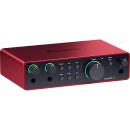
Focusrite Scarlett 2i2 (4th Generation) |
VS | ||||||||||||||
|---|---|---|---|---|---|---|---|---|---|---|---|---|---|---|---|
| Analog: 2 Inputs / 2 Outputs at 192 kHz |
Channels of I/O |
Analog: 2 Inputs / 2 Outputs at 192 kHz |
Analog: 2 Inputs / 2 Outputs |
Analog: 2 Inputs / 4 Outputs at 192 kHz |
Analog: 2 Inputs / 2 Outputs at 192 kHz |
Analog: 2 Inputs / 2 Outputs |
Analog: 2 Inputs / 2 Outputs at 192 kHz |
Analog: 2 Inputs / 6 Outputs at 96 kHz Digital: 8 Input / 0 Output at 48 kHz |
Analog: 2 Inputs / 2 Outputs at 96 kHz |
Analog: 4 Input / 4 Output at 192 kHz |
Analog: 4 Inputs / 4 Outputs at 192 kHz |
1 Input / 2 Output |
Analog: 2 Inputs / 2 Outputs at 96 kHz |
Analog: 1 Input / 2 Outputs at 48/96 kHz |
Analog: 2 Input / 2 Output Digital: Digital I/O |
| 192 kHz / 24-Bit | Maximum Sampling Rate | 192 kHz / 24-Bit | 192 kHz / 24-Bit | 192 kHz / 24-Bit | 48 kHz / 24-Bit | 192 kHz / 24-Bit | 192 kHz / 24-Bit | 96 kHz / 24-Bit | 96 kHz / 24-Bit | 192 kHz / 24-Bit | 192 kHz / 24-Bit | 96 kHz / 24-Bit | 96 kHz / 24-Bit | 96 kHz / 24-Bit | 48 kHz / 24-Bit |
| 2 | Number of Microphone Inputs | 2 Preamps | 2 Preamps | 2 Preamps | 2 Preamps | 2 Preamps | 1 | 2 Preamps | 1 Preamp | 2 Preamps | 2 | 1 | 2 Preamps | 1 Preamp | 2 |
| 2x XLR 3-Pin Balanced Mic Input 2x 1/4" TRS Balanced/Unbalanced Line/Hi-Z Input (Front Panel) 2x 1/4" TRS Balanced Monitor Output 1x 1/4" TRS Headphone Output (Front Panel) |
Analog Audio I/O |
2x Combo XLR-1/4" TRS Balanced/Unbalanced Mic/Line/Hi-Z Input 2x 1/4" TRS Balanced Line/Monitor Output 1x 1/4" TRS Unbalanced Headphone Output |
2x Combo XLR-1/4" TRS Balanced/Unbalanced Mic/Line/Hi-Z Input 1x 1/4" TRS Unbalanced Headphone Output 2x 1/4" TRS Balanced Line Output (DC-Coupled) 2x RCA TS Unbalanced Line Output |
2x Combo XLR-1/4" TRS Balanced/Unbalanced Mic/Line/Hi-Z Input 2x 1/4" TRS Balanced Monitor Output 4x RCA TS Unbalanced Line Output 2x 1/4" TRS Unbalanced Headphone Output |
2x Combo XLR-1/4" TRS Balanced/Unbalanced Mic/Line/Hi-Z Input (Front Panel) 2x 1/4" TRS Balanced Line Output 1x 1/4" TRS Unbalanced Headphone Output (Front Panel) |
2x Combo XLR-1/4" TRS Balanced/Unbalanced Mic/Line/Hi-Z Input (Front Panel) 2x 1/4" TRS Balanced Monitor Output 1x 1/4" TRS Unbalanced Headphone Output (Front Panel) |
1x XLR 3-Pin Balanced Mic Input 1x 1/4" TS Unbalanced Line/Hi-Z Input (Front Panel) 2x 1/4" TRS Balanced Monitor Output 1x 1/4" TRS Headphone Output (Front Panel) |
2x Combo XLR-1/4" TRS Balanced Mic/Line Input 1x 1/4" TRS Unbalanced Hi-Z Input (Front Panel) 4x 1/4" TRS Balanced Line/Monitor Output 1x 1/4" TRS Unbalanced Headphone Output (Front Panel) 1x 1/8" / 3.5 mm TRS Unbalanced Headphone Output (Front Panel) |
1x Combo XLR-1/4" TRS Balanced Mic/Line Input 1x 1/4" TRS Unbalanced Hi-Z Input (Front Panel) 2x 1/4" TRS Balanced Monitor Output 1x 1/4" TRS Unbalanced Headphone Output (Front Panel) 1x 1/8" / 3.5 mm TRS Unbalanced Headphone Output (Front Panel) |
2x Combo XLR-1/4" TRS Balanced/Unbalanced Mic/Line/Hi-Z Input (Front Panel) 2x 1/4" TRS Balanced Line Input 4x 1/4" TRS Balanced Line Output 1x 1/4" TRS Unbalanced Headphone Output (Front Panel) |
2x Combo XLR-1/4" 3-Pin Balanced/Unbalanced Mic/Line/Hi-Z Input (Front Panel) 2x 1/4" TRS Balanced/Unbalanced Line Input 4x 1/4" TRS Balanced/Unbalanced Line/Monitor Output 1x 1/4" TRS Headphone Output (Front Panel) |
1x Combo XLR-1/4" TRS Mic/Line Input 2x 1/4" TRS Balanced Line Output 1x 1/4" TRS Headphone Output |
2x Combo XLR-1/4" TRS Balanced Mic/Line Input 1x 1/4" TS Unbalanced Hi-Z Input 2x 1/4" TRS Balanced Monitor Output 1x 1/4" TRS Unbalanced Headphone Output |
1x XLR 3-Pin Balanced Mic Input 1x 1/8" / 3.5 mm TRS Headphone Output |
2x XLR 3-Pin Balanced Mic Input 1x 1/8" / 3.5 mm TRRS Unbalanced Smartphone In/Out 2x 1/4" TRS Unbalanced Headphone Output 2x 1/4" TRS Balanced Monitor Output |
| Digital Audio I/O | - | - | - | - | - | 1x TOSLINK Optical ADAT / S/PDIF Input (S/MUX Support) | - | - | - | - | |||||
| 1x USB-C | Host Connection | 1x USB-C (Class-Compliant) | 1x USB-C | 1x USB-C | 1x USB-B (Class-Compliant) | 1x USB-C | 1x USB-C | 1x USB-C | 1x USB-C | 1x USB-C | 1x USB-C | USB-C | 1x USB-C | 1x USB-C | 1x USB-C (Class-Compliant) |
| macOS Windows |
OS Compatibility |
macOS 10.13 or Later (64-Bit Only) Windows 10 or Later (64-Bit Only) |
macOS 10.11 or Later Windows 7 or Later 9 or Later |
macOS 10.11 macOS 10.12 macOS 10.13 macOS 10.14 macOS 10.15 Windows 8.1 Windows 10 |
macOS 10.8 or Later Windows 7 or Later (32-/64-Bit) |
macOS 10.14 or Later Windows 10 (64-Bit Only) 14 or Later iPadOS 14 or Later |
macOS Windows |
macOS 10.11.6 or Later macOS 11.1 or Later Windows 7 or Later |
macOS 10.11.6 or Later macOS 11.1 or Later Windows 7 or Later 6 or Later iPadOS |
macOS 10.12 or Later Windows 7 or Later |
macOS Windows |
macOS 10.10 or Later Windows 7 or Later |
macOS 10.7.5 or Later Windows 7 or Later (32-/64-Bit) 6 or Later |
Windows 10 |
macOS Windows iPadOS |
| USB Bus Power, USB Power Adapter (Not Included) | Power Requirements | USB Bus Power | USB Bus Power | USB Bus Power | USB Bus Power | AC/DC Power Adapter (Not Included) or USB Bus Power | USB Bus Power, USB Power Adapter (Not Included) | USB Bus Power | USB Bus Power | USB Bus Power | USB Bus Power, USB Power Adapter (Not Included) | USB Bus Power | USB Bus Power | USB Bus Power | AC/DC Power Adapter (Not Included) or USB Bus Power |
